Military and municipal issues in Sonora
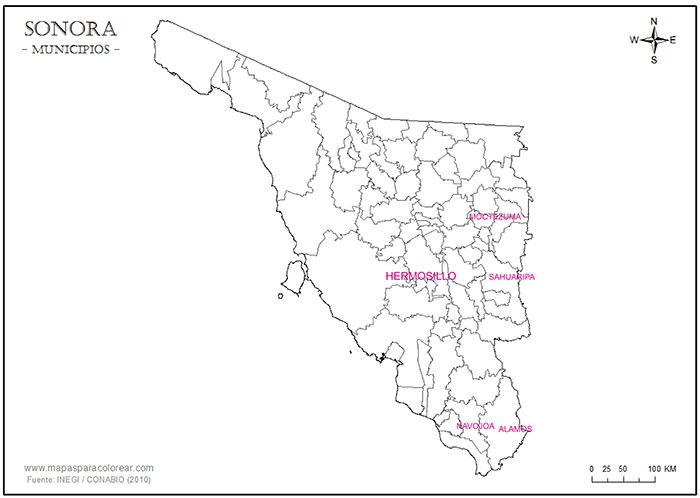
We know of four issues from military or municipal commanders.
Navojoa
On 9 August 1914 Coronel Ramón Gómez rose in revolt at Navojoa with the forces under his command, disowning Carranza and proclaiming for Maytorena. Gómez removed all the federal and municipal employees whom he considered hostile to his cause and replaced them with his own supporters. He authorised an issue of vales to pay the costs of his troops and extended his sphere of action as far as the city of AlamosFrancisco Almada, La Revolución en el Estado de Sonora, Mexico, 1971.
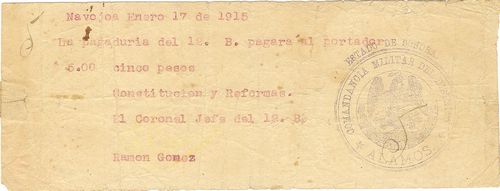 M3795 $5 La Pagaduria del 12o. Battalón
M3795 $5 La Pagaduria del 12o. Battalón
There survives a type-written, handsigned note for five pesos dated 17 January 1915. The text reads ‘Navojoa Enero 17 de 1915 La pagaduria del 12. B pagará al portador $5-00 cinco pesos Constitucion y Reformas El Coronel Jefe del 12 B. Ramon Gomez’ and the stamp is of the Comandancia Militar del Distrito in Alamos.
Sahuaripa
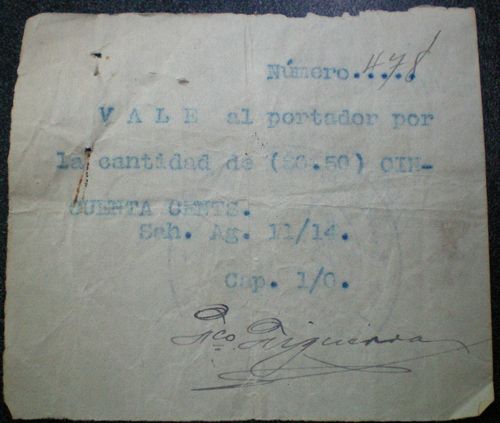
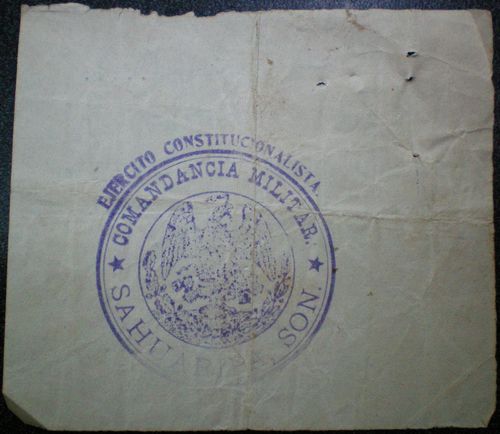 M3797 50c Comandancia Militar
M3797 50c Comandancia Militar
| from | to | total number |
total value |
||
| 50c | includes number 478 |
On 21 August 1914 the Prefecto of Sahuaripa, Federico Meza, reported to Hermosillo that the local army was using scrip as a temporary measureAGHES, Fondo Oficialidad Mayor, tomo 2993. The one surviving 50c note is 75mm by 85mm, numbered 478 and signed by Captain Francisco Figueroa.
| Francisco Figueroa |  |
Moctezuma
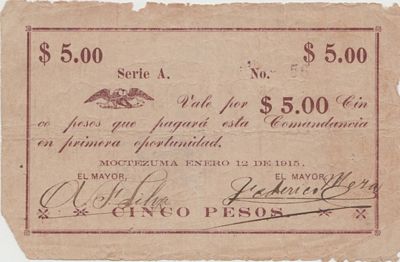
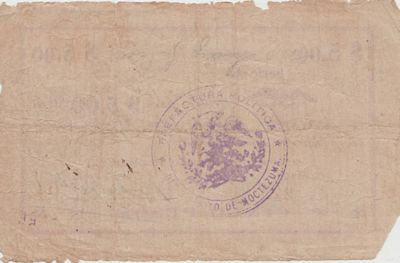 M3794 $5 Comandancia Militar
M3794 $5 Comandancia Militar
| series | from | to | total number |
total value |
||
| $5 | A | includes number 56 |
Notes were later issued to pay the troops in Moctezuma and we know of a $5 note dated 12 January 1915 signed by [ ] Francisco Silvas and Federico Meza.
| [ ] Francisco Silvas was the Prefect of Moctezuma. |  |
| Federico Meza is recorded as joining the Ejercito Constitucionalista as a mayor on 29 September 1913. He was Comisario de Policía in Agua Prieta by 19 November 1913AGHES, Fondo Oficialidad Mayor, tomo 2971, telegram to Comisario de Policía, Federico Meza, Agua Prieta, 19 November 1913 and Prefecto of the Distrito of Sahuaripa by 18 March 1914. By January 1915 he had moved on to Moctezuma. |  |
Five pesos is quite a large denomination, especially for troops to use to purchase supplies, so there were no doubt other denominations.
On 28 January 1915 the Presidente Municipal of Banámichi asked whether the notes (billetes o valores) issued by the Comandancia of Moctzuma and signed by Majors Silvas and Meza were of forced acceptance, as businesses were refusing themAGHES, Fondo Oficialidad Mayor, tomo 3023. The next day the request was forwarded to governor Maytorena in NogalesAGHES, Fondo Oficialidad Mayor, tomo 3023, Año 1915 Movimiento de Fuerzas, letter to Maytorena, Nogales, 29 January 1915, as recorded in AGN, colección Manuel González Ramírez 98/92. Late in February the El Paso Morning Times reported that Francisco Silvas, the Prefect of the Moctezuma district, had issued currency marked ‘Payable at Earliest Convenience’ El Paso Morning Times, 26 February 1915.
On 10 May the state governor was asked to tell the Stamp Office (Administración Subalterna del Timbre) at Sahuaripa to accept the paper money that Prefecto Mesa (sic) had issued to pay the troops under his command as this money was no longer being used and accepting it would help to reduce the amount in circulationAGHES, Fondo Oficialidad Mayor, tomo 3024.
Alamos
The town council (ayuntamiento) at Alamos issued $1 and $2 cartones dated 1 July 1916 payable in Carranza’s infalsificable currency.
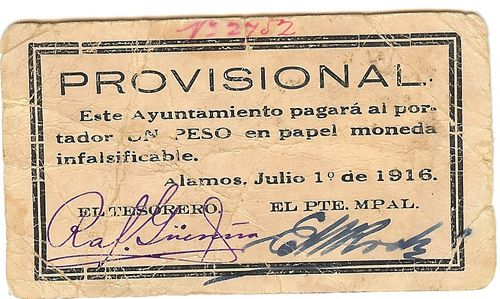 M3799a $1 Ayuntamiento
M3799a $1 Ayuntamiento
There was a typo 'UN PESOS'. Were all these were signed by Santoyo and therefore a later print run?
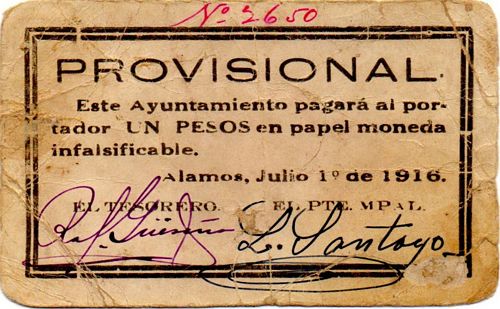
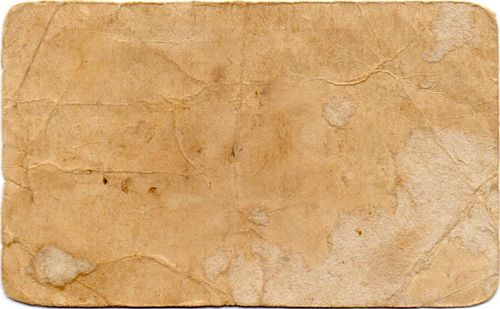
M3799b $1 Ayuntamiento 'UN PESOS'
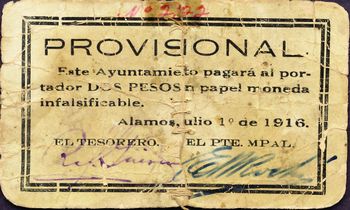 M3800 $2 Ayuntamiento
M3800 $2 Ayuntamiento
Some $2 notes had a larger 'A' in 'Alamos'.
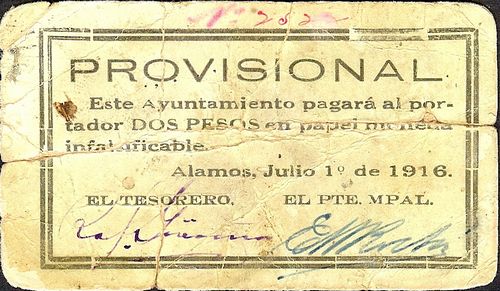 M3800 $2 Ayuntamiento
M3800 $2 Ayuntamiento
| from | to | total number |
total value |
Presidente Municipal |
||
| $1 | Rochin | includes numbers 862 to 1555CNBanxico #6247 | ||||
| Santoyo | UN PESOS includes numbers 2262CNBanxico #6248 to 2650 |
|||||
| Rochin | includes number 2752 | |||||
| $2 | Rochin | includes numbers 1621CNBanxico #12089 to 2192 |
These are signed by Rafael Guereña as Treasurer and either Enrique M. Rochin or Leonardo Santoyo as President Municipal. Rochin was Presidente for the year 1916-1917, whilst Santoyo was never elected Presidente in his own right and must have signed as an interim measure. As, in an early version of a Truth and Reconciliation Commission, Sonoran public employees had to complete a questionnaire about their activities during the revolution we known something of these minor officialsAGHES, Fondo Oficialidad Mayor, tomo 3064. The questionnaire included the following questions:
1) What employment did you have under Diaz, when were you named, and why did you quit? 2) What were your reasons for leaving? 3) During the political struggle under Diaz, which side did you associate with and how did you participate? 4) What part did you play in the struggle during 1909-1910? Were you a civil or a military participant working for the revolution? Specify concrete actions. 5) What functions did you fulfil under Madero, elected or appointed? 6) How long did you serve, and why did you leave? 7) In which political contest have you figured as a candidate for public office, and which elements aided you? 8} Were you involved as an armed citizen or as a civil element against Huerta; when did you commence and what did you do? 9} have you been an office holder in Sonora? Elected or appointed? 19) Why and when did you leave your above position? 11) What part did you play in the conflict between Calles and Maytorena beginning in 1914 when the military was in Hermosillo trying to combat Maytorena' s treason? 12) Why did you remain in territory occupied by the villista-maytorenistas when Calles evacuated Hermosillo to concentrate in the north, beginning also in 1914? 13) What attitude did you assume toward the Convention's rebellion against Carranza? Mention clearly and precisely your actions. 14) Were you employed under that conventionalist regime or were you on the side of Carranza? Cite dates and happenings. 15) Did you serve the constitucionalistas beginning February, 1913? If yes, how, when and where? 16) Have you left your posts in the constitucionalista government? If yes, why? 17) Have you documents to affirm your acts?.
|
Rafael Guereña was a photographer, who also sold his creations from his workshop as postcards. Guereña was interim Tesorero Municipal from 18 April 1913 and Tesorero Municipal from 10 December 1913 to 23 September 1914, when he lost his office because of his political allegiances, but continued being the Carrancista Tesorero General. |
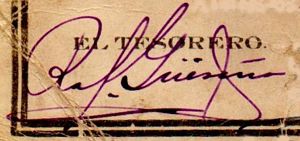 |
|
Enrique M. Rochin Rochin’s questionnaire is missing apart from its coversheet but from elsewhere we know that he was running a jewellers and watch shop in Alamos in December 1909, and that he was one of the volunteers who defended Alamos from a Villista attack in [ ] and was taken prisoner. Rochin was Presidente Municipal from July 1916 to June 1917. He also wrote poetry and pro-Carranza polemics. |
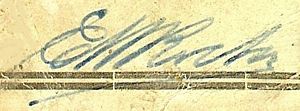 |
|
Leonardo Santoyo was elected to the council on 4 October 1915 and was senior alderman (Primer Regidor) in September 1916. He was never elected Presidente Municipal so must have signed in an interim position. |
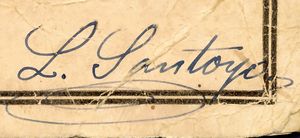 |
